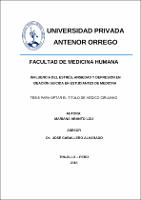Influencia del estrés, ansiedad y depresión en ideación suicida en estudiantes de medicina

Ver/
Descargar
(application/pdf: 659.0Kb)
(application/pdf: 659.0Kb)
Fecha
2018Autor(es)
Abanto Lou, Mariana
Metadatos
Mostrar el registro completo del ítemResumen
OBJETIVO: Determinar si el estrés, ansiedad y depresión influyen en ideación suicida en estudiantes de medicina.
MATERIAL Y MÉTODO: Se realizó un estudio observacional, analítico de corte transversal, que evaluó a 442 estudiantes de los primeros años de estudio en la Universidad Privada Antenor Orrego. Se aplicó una encuesta virtual donde estuvieron variables sociodemográficas, el test DASS 21 y el SBQ-R. El análisis estadístico utilizado fue la prueba chi-cuadrado para variables cualitativas y la t de student para variables cuantitativas.
RESULTADOS: La prevalencia de ideación suicida fue 43,67%. Un total de 193 estudiantes reunieron los criterios de ideación suicida y conformaron el grupo de casos y 249 estudiantes conformaron los controles; el análisis bivariado identificó al género masculino, edad, padres divorciados/separados, problemas emocionales, la presencia de depresión, ansiedad y estrés como variables asociadas a ideación suicida. El análisis multivariado a través de la regresión logística, identificó al género femenino, vivir con sus padres, jugar videojuegos y la presencia de depresión y estrés como factores de riesgo independientemente asociados a ideación suicida.
CONCLUSIONES: Existe influencia del estrés, ansiedad y depresión en la aparición de ideación suicida. Las variables con mayor significancia fueron el género femenino, la edad, padres divorciados o separados, problemas emocionales, depresión, ansiedad y estrés. OBJECTIVE: To determine if stress, anxiety and depression influence suicidal ideation in medical students.
MATERIAL AND METHODS: An observational, analytical cross-sectional study was conducted, which evaluated 442 students from the first years of the career at Universidad Privada Antenor Orrego. A virtual survey was applied where there were sociodemographic variables, the DASS 21 test and the SBQ-R. The statistical analysis used was the chi-square test for qualitative variables and the student's t-test for quantitative variables.
RESULTS: The prevalence of suicidal ideation was 43,67%. A total of 193 students met the criteria of suicidal ideation and formed the group of cases and 249 students formed the controls; the bivariate analysis identified the masculine gender, age, divorced / separated parents, emotional problems, the presence of depression, anxiety and stress as variables associated with suicidal ideation. The multivariate analysis through logistic regression identified the female gender, living with their parents, playing video games and the presence of depression and stress as risk factors independently associated with suicidal ideation.
CONCLUSIONS: There is influence of stress, anxiety and depression in the appearance of suicidal ideation. The variables with the greatest significance were the female gender, age, divorced or separated parents, emotional problems, depression, anxiety and stress.
Colecciones
- Medicina Humana [2984]

